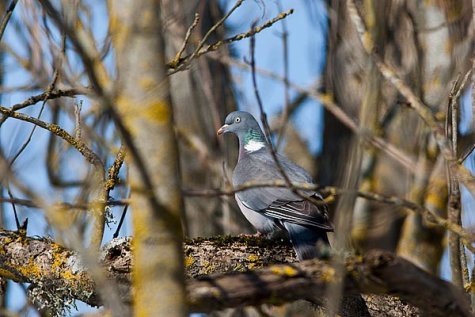Pigeons flying ...
Photo: Kaarel Kaisel
Translation: Liis
Kaelustuvi
| Wood pigeon, Wood dove | Meigas e kaelustuvi | Columba palumbus |
And not only in settlements. The familiar wing clapping sound of domestic pigeons feels strange in a forest at first, but related species are warned by it too. The wood pigeon is the dominating pigeon species in Estonian nature and their number is about the same as that of domestic pigeons – fifty to eighty thousand birds.
Pine forests are generally avoided but all other forest types, gardens and parks are suitable. The forest pigeon is larger than other pigeons, with a comparatively long tail. The white patches on the neck and wings are characteristic. The traditionally pigeon-coloured head and throat are blue-grey, the sides of the neck beside the white patches gleam in metallic green and wine red. The breast and most of the underparts are also wine red. The sexes are similar; young birds are darker and lack the white neck patches.
The before-nesting low pigeon cooing is still to come.
Stock pigeons (Columba oenas) have arrived too and have been seen.
On the Tõrva birdwatchers' home page is a comprehensive table with the arrivals of migrating birds, comparing the years:
A link to the bird watchers' home page is in the left-hand column on Looduskalender's front page: look for Linnuvaaatlejad under the "Partners“ heading.









